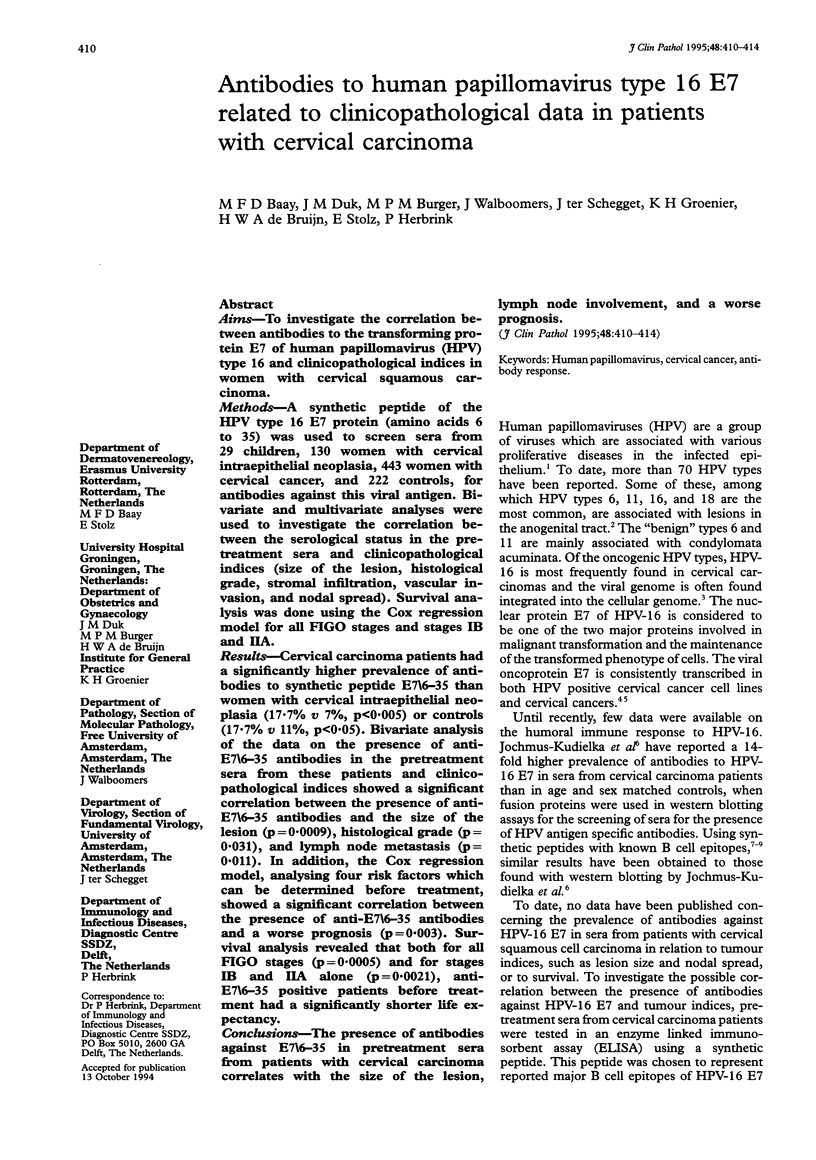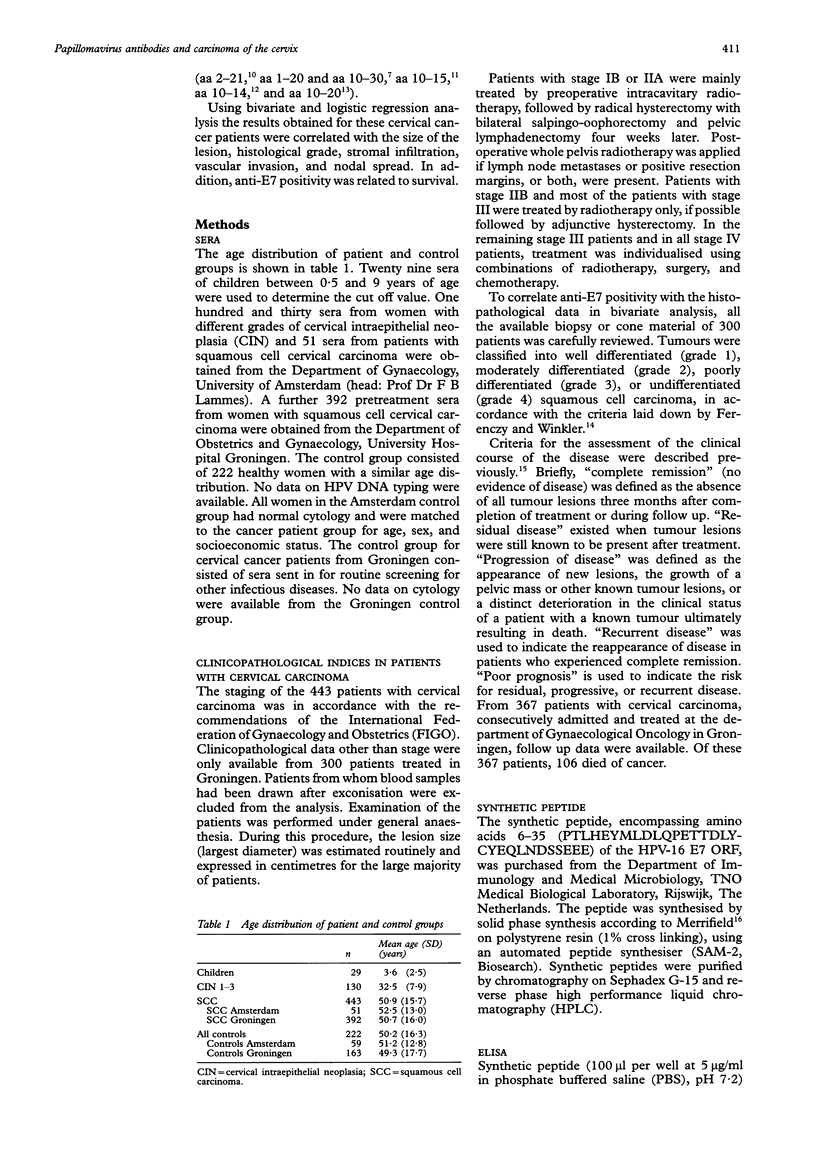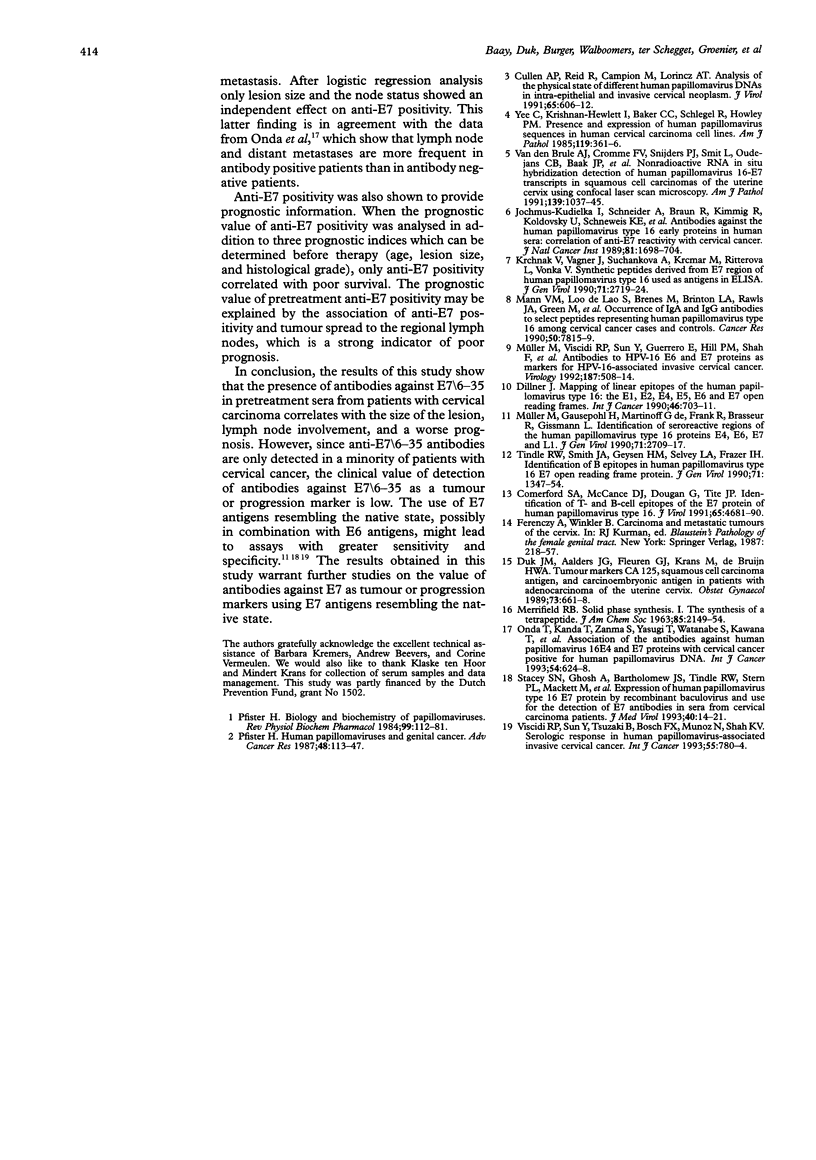Abstract
AIMS--To investigate the correlation between antibodies to the transforming protein E7 of human papillomavirus (HPV) type 16 and clinicopathological indices in women with cervical squamous carcinoma. METHODS--A synthetic peptide of the HPV type 16 E7 protein (amino acids 6 to 35) was used to screen sera from 29 children, 130 women with cervical intraepithelial neoplasia, 443 women with cervical cancer, and 222 controls, for antibodies against this viral antigen. Bivariate and multivariate analyses were used to investigate the correlation between the serological status in the pretreatment sera and clinicopathological indices (size of the lesions, histological grade, stomal infiltration, vascular invasion, and nodal spread). Survival analysis was done using the Cox regression model for all FIGO stages and stages IB and ILA. RESULTS--Cervical carcinoma patients had a significantly higher prevalence of antibodies to synthetic peptide E7/6-35 than women with cervical intraepithelial neoplasia (17.7% v 7%, p < 0.005) or controls (17.7% v 11%, p < 0.05). Bivariate analysis of the data on the presence of anti-E7/6-35 antibodies in the pretreatment sera from these patients and clinicopathological indices showed a significant correlation between the presence of anti-E7/6-35 antibodies and the size of the lesion (p = 0.0009), histological grade (p = 0.0031), and lymph node metastasis (p = 0.01). 0.011). In addition, the Cox regression model, analysing four risk factors which can be determined before treatment, showed a significant correlation between the presence of anti-E7/6-35 antibodies and a worse prognosis (p = 0.003). Survival analysis revealed that both for all FIGO stages (p = 0.0005) and for stages IB and IIA alone (p = 0.0021), anti-E7/6-35 positive patients before treatment had a significantly shorter life expectancy. CONCLUSIONS--The presence of antibodies against E7/6-35 in pretreatment sera from patients with cervical carcinoma correlates with the size of the lesions, lymph node involvement, and a worse prognosis.
Full text
PDF




Selected References
These references are in PubMed. This may not be the complete list of references from this article.
- Comerford S. A., McCance D. J., Dougan G., Tite J. P. Identification of T- and B-cell epitopes of the E7 protein of human papillomavirus type 16. J Virol. 1991 Sep;65(9):4681–4690. doi: 10.1128/jvi.65.9.4681-4690.1991. [DOI] [PMC free article] [PubMed] [Google Scholar]
- Cullen A. P., Reid R., Campion M., Lörincz A. T. Analysis of the physical state of different human papillomavirus DNAs in intraepithelial and invasive cervical neoplasm. J Virol. 1991 Feb;65(2):606–612. doi: 10.1128/jvi.65.2.606-612.1991. [DOI] [PMC free article] [PubMed] [Google Scholar]
- Dillner J. Mapping of linear epitopes of human papillomavirus type 16: the E1, E2, E4, E5, E6 and E7 open reading frames. Int J Cancer. 1990 Oct 15;46(4):703–711. doi: 10.1002/ijc.2910460426. [DOI] [PubMed] [Google Scholar]
- Duk J. M., Aalders J. G., Fleuren G. J., Krans M., De Bruijn H. W. Tumor markers CA 125, squamous cell carcinoma antigen, and carcinoembryonic antigen in patients with adenocarcinoma of the uterine cervix. Obstet Gynecol. 1989 Apr;73(4):661–668. [PubMed] [Google Scholar]
- Jochmus-Kudielka I., Schneider A., Braun R., Kimmig R., Koldovsky U., Schneweis K. E., Seedorf K., Gissmann L. Antibodies against the human papillomavirus type 16 early proteins in human sera: correlation of anti-E7 reactivity with cervical cancer. J Natl Cancer Inst. 1989 Nov 15;81(22):1698–1704. doi: 10.1093/jnci/81.22.1698. [DOI] [PubMed] [Google Scholar]
- Krchnák V., Vágner J., Suchánková A., Krcmár M., Ritterová L., Vonka V. Synthetic peptides derived from E7 region of human papillomavirus type 16 used as antigens in ELISA. J Gen Virol. 1990 Nov;71(Pt 11):2719–2724. doi: 10.1099/0022-1317-71-11-2719. [DOI] [PubMed] [Google Scholar]
- Mann V. M., de Lao S. L., Brenes M., Brinton L. A., Rawls J. A., Green M., Reeves W. C., Rawls W. E. Occurrence of IgA and IgG antibodies to select peptides representing human papillomavirus type 16 among cervical cancer cases and controls. Cancer Res. 1990 Dec 15;50(24):7815–7819. [PubMed] [Google Scholar]
- Müller M., Gausepohl H., de Martynoff G., Frank R., Brasseur R., Gissmann L. Identification of seroreactive regions of the human papillomavirus type 16 protein E4, E6, E7 and L1. J Gen Virol. 1990 Nov;71(Pt 11):2709–2717. doi: 10.1099/0022-1317-71-11-2709. [DOI] [PubMed] [Google Scholar]
- Müller M., Viscidi R. P., Sun Y., Guerrero E., Hill P. M., Shah F., Bosch F. X., Muñoz N., Gissmann L., Shah K. V. Antibodies to HPV-16 E6 and E7 proteins as markers for HPV-16-associated invasive cervical cancer. Virology. 1992 Apr;187(2):508–514. doi: 10.1016/0042-6822(92)90453-v. [DOI] [PubMed] [Google Scholar]
- Onda T., Kanda T., Zanma S., Yasugi T., Watanabe S., Kawana T., Ueda K., Yoshikawa H., Taketani Y., Yoshiike K. Association of the antibodies against human papillomavirus 16 E4 and E7 proteins with cervical cancer positive for human papillomavirus DNA. Int J Cancer. 1993 Jun 19;54(4):624–628. doi: 10.1002/ijc.2910540417. [DOI] [PubMed] [Google Scholar]
- Pfister H. Human papillomaviruses and genital cancer. Adv Cancer Res. 1987;48:113–147. doi: 10.1016/s0065-230x(08)60691-0. [DOI] [PubMed] [Google Scholar]
- Stacey S. N., Ghosh A., Bartholomew J. S., Tindle R. W., Stern P. L., Mackett M., Arrand J. R. Expression of human papillomavirus type 16 E7 protein by recombinant baculovirus and use for the detection of E7 antibodies in sera from cervical carcinoma patients. J Med Virol. 1993 May;40(1):14–21. doi: 10.1002/jmv.1890400105. [DOI] [PubMed] [Google Scholar]
- Tindle R. W., Smith J. A., Geysen H. M., Selvey L. A., Frazer I. H. Identification of B epitopes in human papillomavirus type 16 E7 open reading frame protein. J Gen Virol. 1990 Jun;71(Pt 6):1347–1354. doi: 10.1099/0022-1317-71-6-1347. [DOI] [PubMed] [Google Scholar]
- Viscidi R. P., Sun Y., Tsuzaki B., Bosch F. X., Muñoz N., Shah K. V. Serologic response in human papillomavirus-associated invasive cervical cancer. Int J Cancer. 1993 Nov 11;55(5):780–784. doi: 10.1002/ijc.2910550515. [DOI] [PubMed] [Google Scholar]
- Yee C., Krishnan-Hewlett I., Baker C. C., Schlegel R., Howley P. M. Presence and expression of human papillomavirus sequences in human cervical carcinoma cell lines. Am J Pathol. 1985 Jun;119(3):361–366. [PMC free article] [PubMed] [Google Scholar]
- van den Brule A. J., Cromme F. V., Snijders P. J., Smit L., Oudejans C. B., Baak J. P., Meijer C. J., Walboomers J. M. Nonradioactive RNA in situ hybridization detection of human papillomavirus 16-E7 transcripts in squamous cell carcinomas of the uterine cervix using confocal laser scan microscopy. Am J Pathol. 1991 Nov;139(5):1037–1045. [PMC free article] [PubMed] [Google Scholar]


